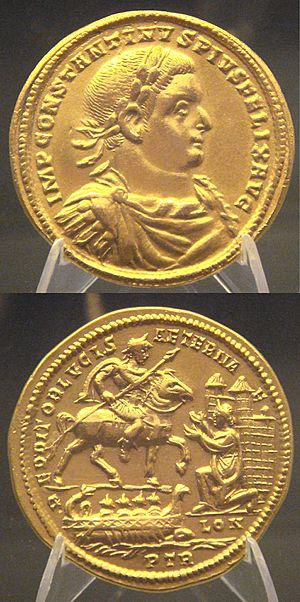Allectus facts for kids
Quick facts for kids Allectus |
|||||||||
|---|---|---|---|---|---|---|---|---|---|
| Augustus of Gaul and Britannia | |||||||||

Allectus on a coin, with a
galley on the reverse. |
|||||||||
| Emperor of Britannia | |||||||||
| Reign | 293-296 | ||||||||
| Predecessor | Carausius | ||||||||
| Successor | None | ||||||||
| Died | 296 Britannia |
||||||||
|
|||||||||
Allectus (died 296) was a Roman leader in Britain. He took power from another ruler, Carausius. Allectus ruled parts of Britain and northern Gaul from 293 to 296. He was like a self-declared emperor, not chosen by the main Roman Empire.
Contents
Allectus's Rise to Power
Allectus was the treasurer for Carausius. Carausius was a Roman navy officer. He had taken control of Britain and northern Gaul in 286. In 293, Carausius faced problems. The Roman leader Constantius Chlorus took back some of Carausius's lands in Gaul. This included the important port of Bononia (now Boulogne). Constantius also defeated Carausius's allies.
Allectus then killed Carausius. After that, Allectus took control himself. He became the new ruler of Britain and parts of Gaul.
Allectus's Time as Ruler
Not much is known about Allectus's time as ruler. However, coins from his rule have been found. These coins are similar to those of Carausius. They show that Allectus still controlled parts of northwestern Gaul. This means that losing Bononia did not end his rule there.
In September 296, Constantius launched an invasion. He wanted to remove Allectus from power. Constantius's ships sailed in different groups. Constantius led one group from Bononia. Bad weather seemed to delay him.
Another group was led by Asclepiodotus. He was a high-ranking Roman official. His ships used fog to avoid Allectus's navy. Allectus's ships were waiting near the Isle of Wight. Asclepiodotus landed his forces near Southampton Water. They then burned their ships. This meant they had to fight.
Allectus's army had to leave the coast. But another Roman group cut them off. Allectus's forces were defeated in battle. Allectus himself was killed. He had removed his special clothing. He hoped his body would not be recognized.
Archaeologists think the battle happened near Calleva Atrebatum (Silchester). This was an ancient Roman town. Some Roman troops got lost in the fog. They later found Allectus's remaining soldiers. These soldiers were mostly Franks. They were in Londinium (London). The Roman troops defeated them there.
Constantius arrived in Britain after the fighting was over. Roman writers said Britons welcomed him. They saw him as a liberator, or someone who set them free.
In March 2019, an old coin was found in Dover. It showed Allectus's head. A metal detectorist found it. The coin was later sold for a lot of money at an auction.
Allectus in Old Stories
Allectus appears in old stories. One famous story is History of the Kings of Britain. It was written by Geoffrey of Monmouth around 1136. In this story, Allectus is a Roman officer. He is sent to remove Carausius, a British king. Allectus succeeds, but he rules harshly.
Later, Asclepiodotus removes Allectus. Asclepiodotus is called the Duke of Cornwall in this story. Allectus's last soldiers are trapped in London. They surrender, hoping to leave Britain safely. Asclepiodotus agrees to this. However, his allies, the Venedoti, kill the surrendering soldiers. They throw their heads into the Galobroc river.
Allectus in Books
Allectus's story is also in modern books. His killing of Carausius is important. The fight against Allectus's rule is also key. These events are central to the 1957 novel. It is called The Silver Branch. It was written by Rosemary Sutcliff.


